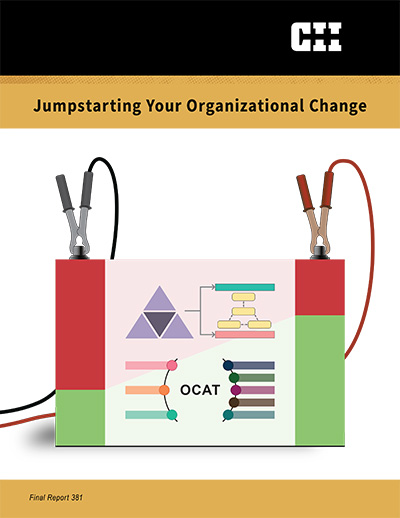
Jumpstarting Your Organizational Change
Studies have shown that approximately 70% of organizational change efforts fail. This is no exception for the capital projects industry. To remain successful in a changing environment, an owner or contractor capital project organization must be able to adapt to change by reconfiguring its structure, people and culture, and processes and technology.
CII commissioned Research Team 381 (RT-381), Adapting through Organizational Agility, to enable capital project organizations to properly plan for and prioritize the critical change practices required to support the successful execution of organizational change. During its research, RT-381 conducted 11 case studies with capital project organizations to learn about past and ongoing organizational changes. The team’s analysis of these case studies enabled it to identify 60 change practices, which it further investigated in a survey that it distributed to professionals in the capital projects industry. The researchers collected a total of 61 complete responses and extracted the following findings for each type of organizational change investigated during this study:
- Critical change practices for the success of an organizational change
- Fundamental change practices for the success of an organizational change
- Change drivers
- Success metrics
- Examples of change practices
RT-381 investigated three general types of organizational change:
- Adapting to transformative change
- Adapting to change with a high degree of agility
- Adapting to transformative change with a high degree of agility
The team also addressed five specific types of organizational change:
- Adapting to a new execution model
- Adapting to digitization
- Adapting to the expansion into new markets
- Adapting to acquisition
- Adapting to low carbon initiatives
Based on this research, RT-381 created an Organizational Change Adaptability Tool (OCAT) to support organizational change initiators, implementers, and managers as they assess and contextualize changes in the external environment and prioritize where to expend effort as their organizations adapt. OCAT allows owner and contractor capital project organizations to jump-start the change planning process more effectively.
The team developed a model to depict the dynamics of organizational change and the elements that must be considered. (See Figure 1.) The model first illustrates how the environment drives organizational change in three dimensions: the weight of the past, the push of the present, and the pull of the future. It then illustrates how change affects four aspects of the organization: strategy, structure, people and culture, and processes and technology.
RT-381 studied case studies and conducted interviews to characterize organizational change in the capital projects industry. Upon this basis, the team identified organizational change in three general types and five specific instances shown in Table 1 (FR-381, p. 13). The team also extracted examples of relevant change practices from the case studies.
RT-381 investigated 11 case studies to document which practices enabled successful change in capital project organizations. The team extracted 60 change practices, then mapped them onto the organizational change model, as Figure 2 shows (FR-381, p. 10).
Figure 2. Detail of a Heatmap for the Organizational Change Model
To add more fidelity and understand the DNA of this model, the team surveyed 61 respondents from owner, contractor, service provider capital project organizations. The findings showed how capital project organizations can position themselves for successful change.
Members: Download this tool from Related Resources, below.
RT-381 developed the Organizational Change Adaptability Tool (OCAT), which is part of Final Report 381 (FR-381, p. 31). OCAT was built in Microsoft Excel and Visual Basic for Applications. The tool helps owner and contractor organizations prepare for and adapt to organizational changes, with specific help for each type of organizational change studied during this research. In this way, OCAT users will have context to learn about a particular change, plan how to implement it, and modify the plan to match unfolding events.
Figure 3. Organizational Change Types Covered by the OCAT


